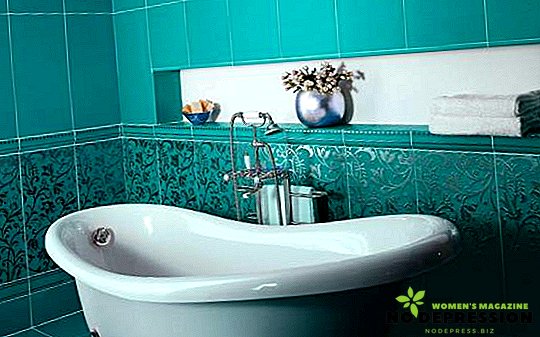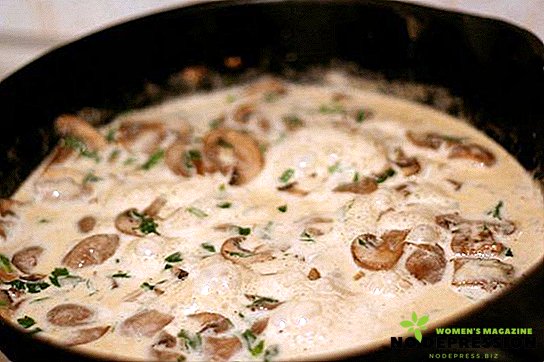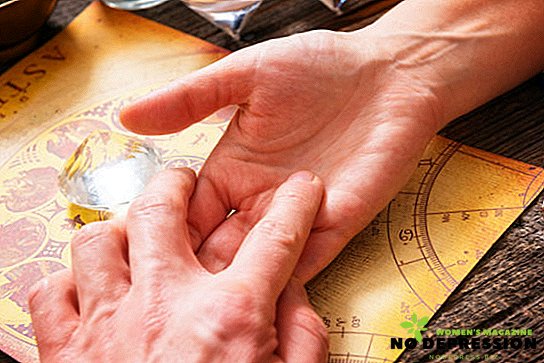Repair in a country house or apartment is not a simple replacement of old materials with new ones. This is not only a cosmetic procedure aimed at improving the state of the home, but also a creative process, which can result in a designer interior.

To make the house cozy and beautiful, and also show the taste and personality of its owners, it is worth carefully selecting all the necessary elements and materials. So, performing the repair of the bathroom, you should focus not only on the plumbing, but also on the environment - tiles on the walls, which will please the eye for a long time with proper selection.
Bathroom tile design and variations
The monotonous blue tile, common in Soviet times, accompanied the bathing of many people. There was no imagination and creativity in it, so many tried to independently give their walls individuality, glue on the walls various decals and stickers with various images.
Fortunately, at the moment in the building stores there are a lot of various tiled products from manufacturers around the world in different price categories.

The tile in the bathroom, in addition to the division into floor and wall, can have many differences in appearance and quality features. Tiles can be monophonic, with a pattern and full-fledged drawings, with photographic design.
The surface of the tile can be smooth, glossy and matte, with different glazes, have three-dimensional and embossed patterns, bulges, combined glazed and unglazed fragments. The design can be used various additional materials and elements, such as stone, glass and mother of pearl, as well as much more.
Patterns and images can be really diverse. Often used floristic and animalistic motifs, images of nature, architectural structures.
A popular theme for tile design is the sea and the ocean, including images of waves, fish, seashells, corals and other marine life. Many tiles repeat the texture or pattern of wood, stone and other materials. The design uses neutral patterns, lines, points, geometry, and more.

In addition, the tile is of various shapes and sizes, not only classic square and rectangular, but also hexagonal, as well as small additional elements.
There are not only plain or patterned tiles laid out in any order, but also dial sets that need to be laid out in a special way to get a pattern, border or a whole large image on the wall. In addition, do not forget about the mosaic and its modern imitation - large tiles with a textured pattern on them.
Types of bathroom tiles
As mentioned above, the tile for the bathroom has a lot of differences on various grounds. Basically, it was about the visual component, but there is another important detail that determines the quality characteristics of the product: what is tile used for. Conventionally, this product can be divided into three types:
- Wall cladding tiles are lighter, however, having a large margin of safety and resistance to moisture and abrasion, they are marked in the form of a square with an image of the palm inside; as a rule, wall tiles have a rectangular shape, but, in general, there are no restrictions;
- The floor tile is more durable and thicker, has an increased coefficient of abrasion, smooth or matte surface, marked with a square with a foot print; most often, the floor tile is square, which is explained by a better distribution of pressure;
- Universal tile is most often a flooring product, but lightweight, and therefore can be used on walls; double marking, square or rectangular geometry.

Technical features of bathroom tile design
In addition to the appearance, the design of the tile must have special technical characteristics. Since the bathroom is a room with high humidity and temperature extremes, the tile must be able to withstand them.
Since ceramics is a porous material that absorbs moisture anyway, all tiles are covered with special waterproof glaze. Unglazed tiles are applicable in rooms with other "climatic" conditions.
In addition, the texture is important. So, for example, on the walls there can be a tile with absolutely any surface, ornaments, protuberances and other things, however, a smooth or rough tile that, in turn, should not be slippery, is best suited to the floor.

The shape and thickness of the material on the floor and walls are also different. The flooring receives a constant point pressure, so the floor is ideal square or hexagonal tiles, whereas on the walls it is more important to distribute the load, so rectangular variants are more often used.
Also, this property affects the thickness of ceramics, respectively. In addition, the flooring is made darker, while the wall can be absolutely any color.

Bathroom tile design: aesthetic moments
In terms of aesthetics, ceramic tiles are currently quite high. The use of various technologies and combinations allow you to create a unique and beautiful coating. The variety of the market of finishing materials amazes the imagination and allows everyone to find a product to your taste and wallet.

Modern tiled products have various styles and designs: minimalism, oriental patterns and ornaments, high-tech, loft design now popular, traditional, but no less appealing mosaic, photo applications, classical plant and animal images, abstraction and much more.

Types of tile materials
Tiles for floors and walls also differ in the number of firing and the presence of glaze. So, the floor burn once, while the wall - twice, as it is covered with icing.

In addition to these varieties, there are also different types of production methods and technologies, due to which the result is different:
- clinker tile - has a high density and small pores, very durable, most often used on the floor, as it has the natural color of clay;
- porcelain stoneware - flooring material with imitation of the surface of natural granite stone;
- Mosaic - currently this beautiful type of material does not require painstaking styling, since small mosaic elements - tessera, are pre-assembled on special grids, thanks to which the mosaic is convenient and easy to stack;
- Italian metlahask tile - high-strength material, produced by double firing from a mixture of clay, which consists of carbonates, sand and iron oxide; as the material is porous, it is used only for wall cladding.

Color solution, fashionable combinations for finishing the bathroom
Now in design there are many different trends that allow to make an ultra-modern interior at its discretion. There are no special limitations in color combinations, however there are some recommendations and styles.

- classic colors that do not lose popularity, for the bathroom are shades of blue and blue, imitating sea and water;
- Monophonic compositions of tiles of the same color, but of a different texture or pattern, combined with each other in different areas of the room are especially popular;
- thanks to the popular loft style, ornaments or textures imitating stone, brick and old painted wood are popular;
- interiors in brown and sand beige shades, in ivory color, with imitation of various stone, wooden materials and the like, do not lose their relevance, and combinations of these colors and their variations look very elegant and elegant;
- minimalistic designs in discreet clean or muted shades look very stylish, especially in combination with sanitary equipment of strict geometric shapes;
- the contrast of the dark floor and light walls is a timeless classic, giving an interesting optical effect; 3D tile images in combination with calm plain walls are also an excellent solution.

Ways of tiling the bathroom
Laying tile can be done in various ways in a geometric sense. For the floor there are several interesting options:
- traditional - laying tiles strictly to each other, side by side;
- with offset - with this method, the odd rows fit in one way, and even so that the middle of each tile is at the junction of the tiles of the previous row; you can also otherwise move the rows;
- Herringbone - a method for a rectangular tile, which is put on the oblique, forming the necessary pattern;
- Christmas tree with an attachment - squares of four tiles laid with a well are laid out on an oblique side, in the center of which an attachment is inserted;
- diagonal styling;
- modular grid - a set of tiles of different sizes.
The methods of wall decoration are similar to those listed, it is also possible to lay out the border with special segments, combining with mosaics and other fantasies.

Design in a large and small bathroom
The difference in the design of a small and spacious bathroom in the optical effects that play into the hands and visually change the space in the right direction. So, a small room is not recommended to trim too dark materials. Light gloss tiles will be a good choice.
It is better to choose monophonic materials, or with a small pattern and geometrical ornaments. Horizontal lines will expand the space and vertical lines will extend. In a large bathroom any design experiments are allowed, and space can be adjusted by resorting to the same optical tricks.
Mosaic is applicable in both versions, but in different combinations. With the right approach, any bathroom can turn into a real resting place not only for the body, but also for the look.
And a few more tips on choosing a tile in the bathroom - in the next video.












